10 Important Panama Canal Facts Everyone Should Know
“Have you ever crossed the Panama Canal?” One of many questions we mariners encounter while interacting with landlubbers is if they are smart enough not to ask questions like “Where do you sleep at night on ship?”.
The Panama Canal is perhaps one of the most remarkable feats of engineering ever conceived by humanity. Its sheer size tells a beautiful tale about human endurance, determination, and accomplishment.
Related Reading: 10 Famous Shipping Canals In The World
As a seafarer, I would say we are a privileged lot who get to see the best artificial waterway in a very intimate way by sailing through it. Thus it would not be wrong to mention that it is a moral obligation for us mariners to know a few intricate facts about this wonder of the modern world, as labeled by the American Society of Civil Engineers.
Let’s take a look at ten crucial Panama Canal facts below:
Who Built The Panama Canal?
Everyone knows that the United States of America built the Panama Canal under President Theodore Roosevelt, but very few know that the French started the work. It was Mr. Ferdinand de Lesseps, a French diplomat, who began the work in 1881. The work had to be stopped in 1894 because yellow fever and malaria claimed the lives of an estimated 22,000 workers, and spending nearly USD 287 million bankrupted Mr. Ferdinand de Lesseps.
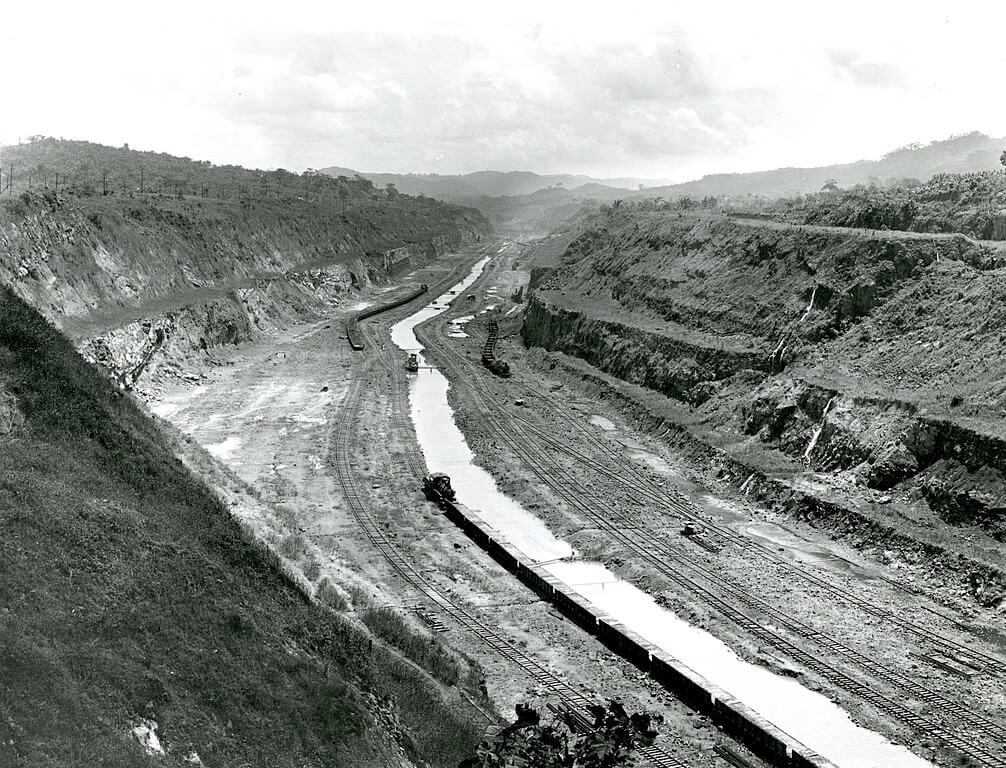
Americans undertook the leftover work in 1904 after helping Panama cede from erstwhile ‘Greater Colombia.’ Constructing a dam to provide water for the canal was a challenge. However, under the able leadership of Mr. John Frank Stevens and later Major George Washington Goethals as chief engineer, the Madden Dam was built, and the canal was completed in 10 years. It was on 15 August 1914, two years before the target year of 1916, when the Panama Canal was officially inaugurated.
Related Read: A Brief History of the Panama Canal
Which was the first vessel to cross the Panama Canal?
As per records, the first ship to cross the Panama Canal was SS Ancon. She was an American flag cargo and passenger ship owned by the Boston Steam Ship Company. She was about 150 meters in length, 18 meters in beam, about 9600 Gross Registered Tonnage, and drew a draft of about 8.8 meters. She played a vital role in building the canal by ferrying workers, construction materials, and, notably massive amounts of cement from New York to Panama for constructing the Panama Canal.
How much time is saved by crossing It?
Panama Canal was first envisioned by Charles V, Holy Roman Emperor and king of Spain, in the year 1534. He was convinced that a canal across the isthmus of Panama would significantly reduce the distance between Spain and Peru, thus giving them a military advantage over the Portuguese. Though it took nearly four centuries for his dream to materialize, since its inauguration, Panama Canal has reduced the sailing distance from the Atlantic to the Pacific and vice versa by a vast 8000 nautical miles (approximately). If we sail with an average speed of about say 15 knots, then it will be 22 long days!
On the contrary, crossing the Panama Canal takes around 8 to 10 hours. Panama Canal not only saves money and time for owners and ship operators but, in fact, also prevents enormous amounts of CO2 emissions, helping the shipping industry to reduce its carbon footprint.
Panama Canal Facts Infographic:
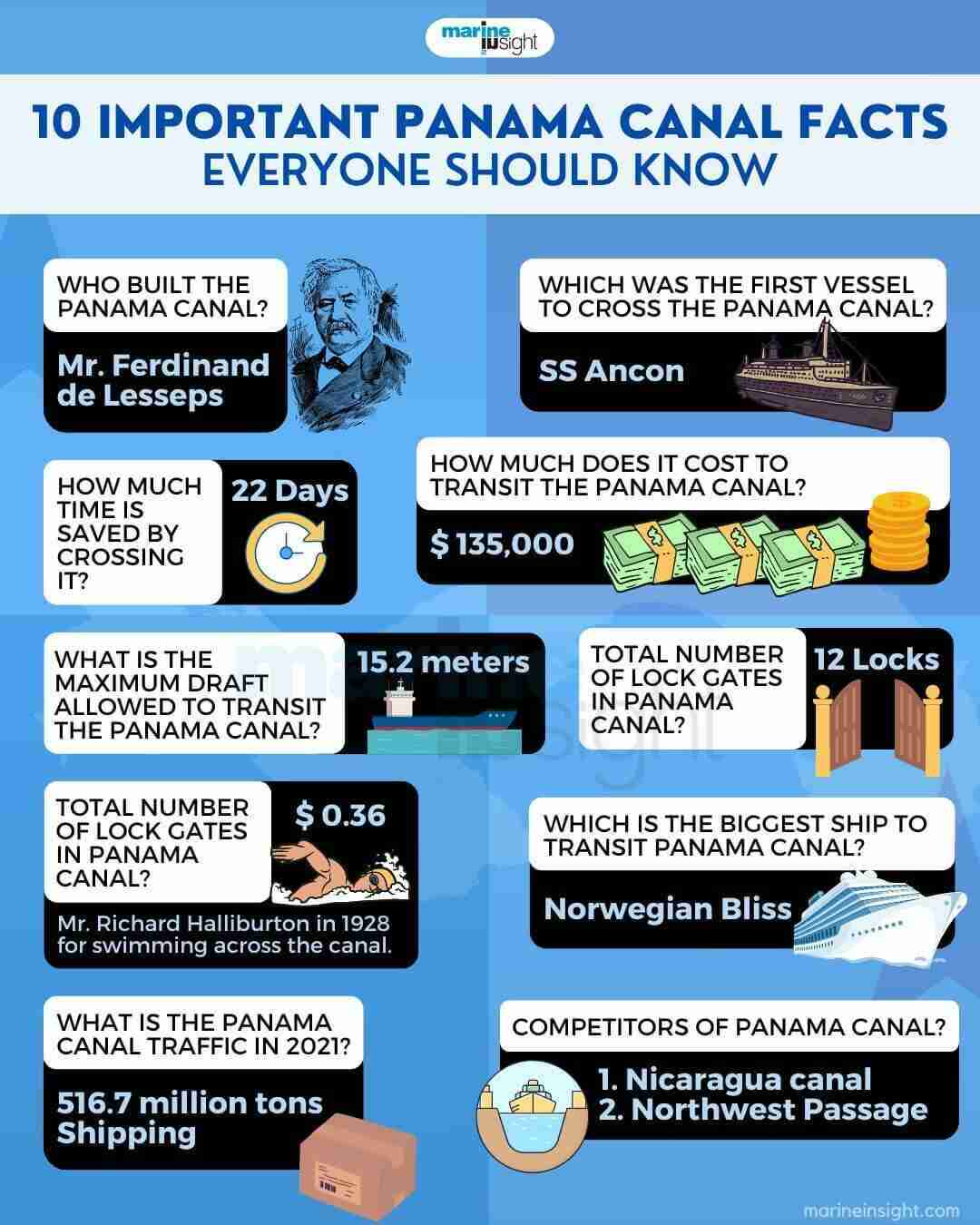
How much does it cost to transit the Panama Canal?
Panama Canal authorities calculate tolls using a Panama Canal Universal Measurement System (PC/UMS), based on the international standard of vessel measurement established by the International Convention of Measurement of Ships in 1969.
A mathematical formula is applied to calculate the total ship’s volume to determine net Canal Tonnage. A net Canal tonnage is 100 cubic feet of volumetric capacity. Then, depending on whether the vessel is laden or in ballast, the appropriate rate is applied. Warships and other Naval Auxiliary vessels are charged based on their displacement tonnage. One displacement ton is equivalent to one long ton or 35 cubic feet of salt water.
For practical purposes, a typical IMO type III chemical tanker of around 50,000 DWT pays around USD 135,000 in toll. In contrast, an LNG tanker of neo-Panamax size 83,000 DWT pays around USD 260,000 in toll. The smallest toll was paid by Mr. Richard Halliburton in the year 1928 of USD 0.36 for swimming across the canal.
Related Read: Different Types of Tankers: Extensive Classification of Tanker Ships
How do the locks work, and why are they there in the first place?
There is a total of twelve locks in the Panama Canal system. The first set of locks from the Pacific entrance to the canal is known as Miraflores locks. It is a two-step flight that lifts or lowers ships 54 feet above the mean sea level. Then comes Pedro Miguel’s locks.
It is a single-step flight that lifts or lowers ships 31 feet above mean sea level. Pedro Miguel locks then lead to Gatun Lake via Culebra cut. The final lock is known as the Gatun Lock. It is a three-step flight that lifts or lowers ships 85 feet above the mean sea level and opens to the Atlantic Ocean. All three sets of locks are in a pair to ensure that, at least in principle, ships pass in opposite directions.
The main purpose of these locks is to ensure that Gatun Lake does not flow outwards to the Atlantic or the Pacific Ocean. This provides sufficient draft is available at all times for ships to pass.
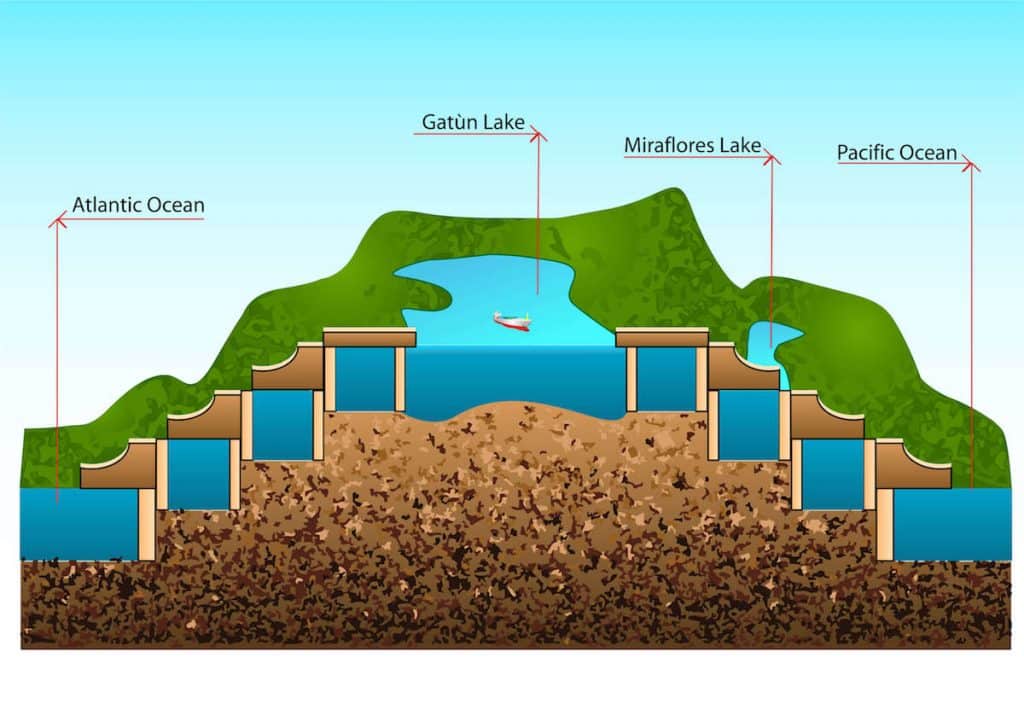
Locks work on the basic principle of gravity and floatation. The height difference between Gatun lake and the Pacific & Atlantic Oceans causes water to flood and empty the locks through culverts. Huge valves control the flow of water. A control centre manages the entire system at respective lock gates. When lock gates flood, the ship floating inside the lock gate rises with the rising water level and then enters the consecutive lock gate for further rise. The same technique is used to lower the ship by emptying the lock gates.
Related Read: How do the Water Locks of Panama Canal Work?
What is the maximum draft allowed to transit the Panama Canal?
Every year ACP (Autoridad del Canal de Panamá) or Panama Canal Authority issues a notice giving details of size and draft limitation for vessels intending to transit the Panama Canal. With the opening of new locks for commercial traffic on 26 June 2016, there are different requirements for ships travelling with old and new locks. Old locks are called Panamax locks, whereas new ones are referred to as neo-Panamax locks.
As of the year, 2018 maximum draft for Panamax locks is 12.04 meters (39 feet 6 inches) of Tropical Fresh Water (TFW). Tropical Fresh Water (TFW) is 0.9954 gms/cc at 29.4°C (85°F). The maximum draft for neo-Panamax locks is 15.2 meters (49.87 feet) of Tropical Fresh Water (TFW).
What are the required pre-arrival preparations?
It is a known fact that the Panama Canal is one of the essential waterways in the world. To ensure the continued safe transit of vessels, there are stringent regulations that control the entire transit system of the Panama Canal. Canal transit should be booked via the agent, who would also send the list of pre-arrival documents. These documents are required for vessel clearance upon arrival.
Vessels arriving at the Atlantic or Pacific anchorages must contact the Port Entry Coordinator (PEC) in Cristobal or Flamenco signal stations on VHF Channel 12 before the evolution occurs. Upon arrival at Atlantic or Pacific anchorages, Panama Canal Authority (ACP) inspectors board the vessel to carry out a pre-transit inspection. All bridge equipment, steering gear, mooring winches, associated equipment, main engine, and other auxiliary machines must work correctly to avoid delays or rejection during ACP inspection.
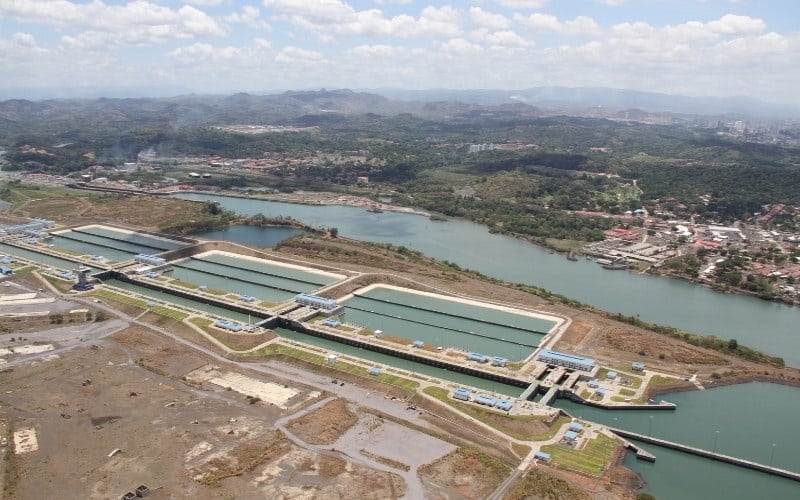
Panama Canal is in ECA (Emission Control Area); thus, before transit, change over from HFO (Heavy Fuel Oil) to LSMGO (Low sulfur marine gas oil) may be required depending on ship type. The ship’s crew should also be familiar with PCSOPEP (Panama Canal Ship Board Oil Pollution Emergency Plan). PCSOPEP notification and oil spill drill per PCSOPEP should also be carried out before arrival.
Related Read: 10 Points to Remember When Transiting a Narrow Channel
Navigation Challenges
Navigating the Panama Canal can be challenging. Though Panama Canal pilots are known for their thorough professionalism and skilled navigation, responsibility for safe navigation lies with the ship’s master and crew.
Special care should be taken, especially when a vessel is in the lock and the locked gate is open. The sudden gush of water creates an effect that local pilots call ‘The Hydraulic Effect,’ this pushes the vessel astern, and full main engine power is required to maintain the position. During this, the forward and aft station duty officer should constantly communicate with the bridge and inform the condition of lines passed by mules.
The other section where special care should be exercised is the ‘Culebra Cut,’ also formally known as the ‘Gaillard Cut.’ This narrow stretch of the Panama Canal cuts through the continental divide in Panama. Sharp-cut and narrow passages make it tricky and challenging.
Honorary Pilots
Interestingly, the Panama Canal Authority (ACP) appoints a few honorary pilots, generally masters, who have completed 100 transits through the Panama Canal. Most recently, Capt. Sonjoy Sen of WWL (Wallenius Wilhelmsen group) received an honorary Panama Canal Pilot’s Licence in 2015.
Commodore Ronald Warwick, master with Cunard Liners who commanded RMS Queen Marry II, was awarded honorary pilot of Panama Canal by Panama Canal Authority (ACP) for crossing Panama Canal more than 50 times.
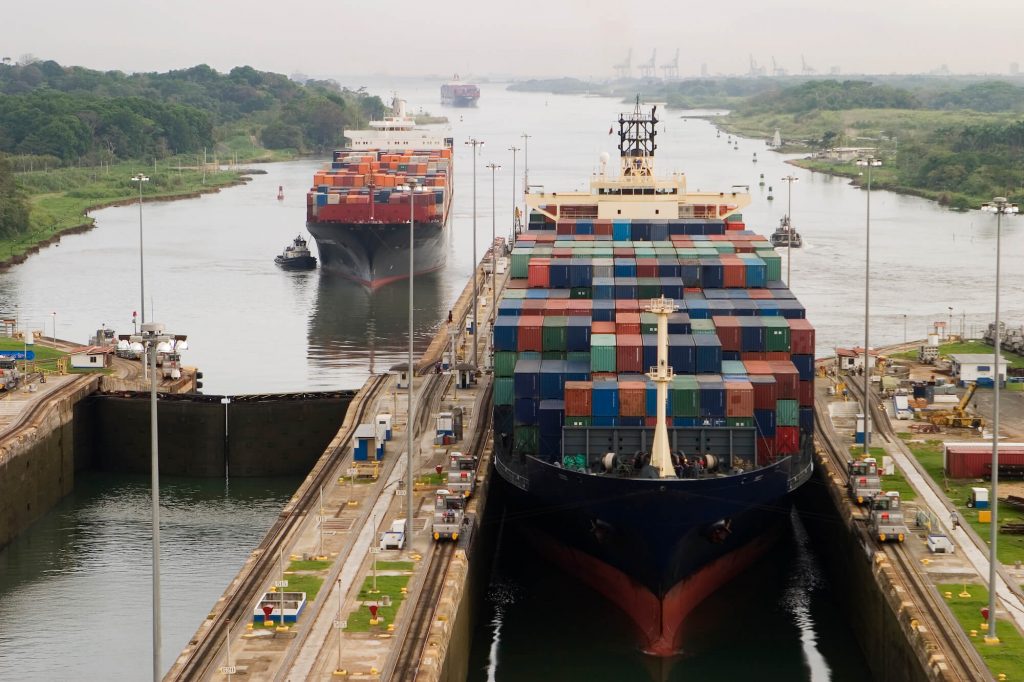
Competitors of the Panama Canal
Although the Panama Canal is the only canal between the Pacific and the Atlantic Ocean, there is also a proposal for another canal to cut across Nicaragua. It is to be known as the Nicaragua Canal.
In 2006, President of Nicaragua Enrique Balaños announced his intention to build this canal. In 2012, the Nicaraguan government, together with Hong Kong Nicaragua Canal Development Investment Company (HKND Group), signed a memorandum of understanding in which HKND Group would finance the entire project and, after completion of the project, would operate it.
However, the Hong Kong Nicaragua Canal Development Investment Company (HKND Group) became bankrupt after the 2015-16 Chinese stock market turbulence. This and local and environmental activists’ protests brought this project to its knees. Despite this, the present Nicaraguan government is committed to constructing this canal. If this project becomes a reality, it may give Panama Canal serious competition.
Reading about the Panama Canal facts gives one a glimpse of this magnificent piece of an engineering marvel. Its true beauty can only be captured and felt by actually sailing through it. We hope all fellow seafarers will sail through it at least once in their lifetime and experience Panama Canal in all its glory.
Do you know any other Panama Canal Fact that can be added to this list?
Let’s know in the comments below.
Frequently Asked Questions About the Panama Canal
1. What is so unique about the Panama Canal?
The Panama Canal joined the Atlantic and Pacific Oceans when it opened in 1914. Hence, it shortened the journey for ships that had to sail through the southern tip of South America.
2. How much distance does Panama Canal Save?
It saves up to 8000 nautical miles, depending on where the ship is sailing from.
3. Why is the Panama Canal so famous?
The canal is popular as it saves time and money and reduces carbon emissions of the shipping industry. It helps shippers to transport grains and other products conveniently and swiftly.
4. Does the Panama Canal make money?
Panama Canal generates enormous revenue from its toll fee. The toll revenue was three billion US Dollars in 2021.
5. Who built the Panama Canal?
Initially, it was the French; however, Theodore Roosevelt negotiated the Hay-Bunau Varilla Treaty, which gave the US control of the canal zone. The US began work in 1904 and completed it in a decade by 1914.
6. How many ships pass through the Panama Canal every day?
Around 40 ships pass through the canal each day.
You may also like to read – the 4th Engineer’s First Journey Through The Panama Canal.
Disclaimer: The author’s views expressed in this article do not necessarily reflect the views of Marine Insight. Data and charts, if used in the article, have been sourced from available information and have not been authenticated by any statutory authority. The author and Marine Insight do not claim it to be accurate nor accept any responsibility for the same. The views constitute only the opinions and do not constitute any guidelines or recommendations on any course of action to be followed by the reader.
The article or images cannot be reproduced, copied, shared, or used in any form without the permission of the author and Marine Insight.
Do you have info to share with us ? Suggest a correction
Latest Shipboard Guidelines Articles You Would Like:
Subscribe To Our Newsletters
By subscribing, you agree to our Privacy Policy and may receive occasional deal communications; you can unsubscribe anytime.








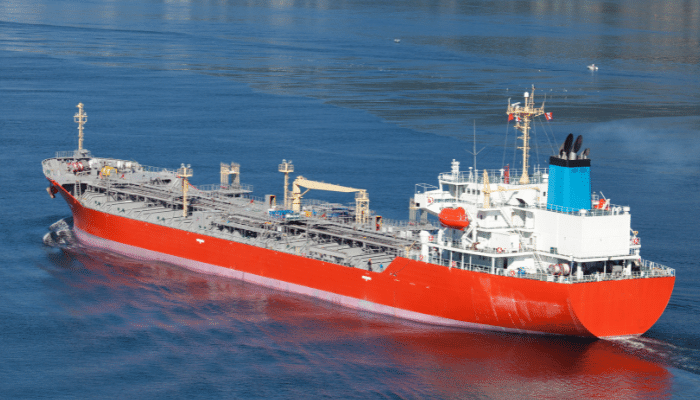






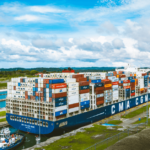
thanks
@Nikolaos: Glad you liked it